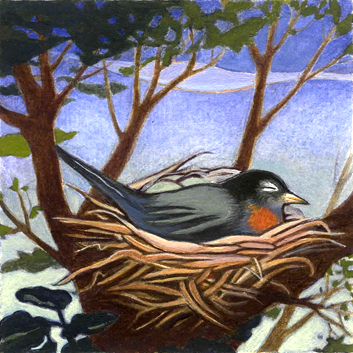|
Posted on 03/23/2014 5:01:48 PM PDT by Kathy in Alaska
|
Hiya Beachie! I sure hope you get some spring-like weather soon, it’s going to be 70 here today :-) But of course there is rain coming soon. OK, I better run, see ya soon.

Good morning Pro ((HUGS))
No spring like weather for several days - BUT weekend looking good.
Where you rushing off to? LOL
Have a marvelicious Monday.
That's good news. ((HUGS))
OMGosh! Great news they arrived safely. Prayers for safe mission and return.
Thanks, Beachy! :) (((hugs)))
((HUGS))Good morning, Beach. How’s it going?
One day at a time...LOL.
Only way!

Good morning EG ((HUGS))
All is well.
Howz it out your way?
 #50
#50((HUGS))Good morning, LUV W. How's it going?
LOL! Who knew! :) thanks!
Howdy! (((Hugs))
Going well.....doing my PT in order to be all better again!
Did ya have a nice birthday?
Sure did...even without wearing a burka! :) Thanks!
Polar Bear Expedition
North Russia Intervention
Polar Bear Expedition ·
Battle of Tulgas ·
Vaga River front (Battle of Ust-Padenga ·
Battle of Shenkursk ·
Battle of Vystavka)·
Battle of Bolshie Ozerki.
Polar Bear Monument in White Chapel Cemetery, Troy, Michigan, sculptor Leon Hermant.
Historical marker for Polar Bear Monument in White Chapel Cemetery, Troy, Michigan.
The Polar Bear Expedition (also known as the Northern Russian Expedition, the American North Russia Expeditionary Force - ANREF or the American Expeditionary Force North Russia - AEFNR) was a contingent of about 5,000 U.S. troops[1] that landed in Arkhangelsk, Russia as part of the Allied intervention in the Russian Civil War and fought the Red Army in the surrounding region during the period of September 1918 through July 1919.
Contents
1 Allied Intervention
2 Campaign
3 Withdrawal
4 Repatriation of the dead
5 Last living member dies
6 See also
7 References
8 Bibliography
9 External links
Allied Intervention
The Polar Bear Expedition was sent to Russia by the U.S. President Woodrow Wilson in response to requests from the governments of Great Britain and France to join the Allied Intervention in North Russia (also known as the North Russia Campaign). The British and French had three objectives for this intervention:
1.preventing Allied war material stockpiles in Archangelsk (originally intended for the recently collapsed Eastern Front) from falling into German or Bolshevik hands
2.mounting an offensive to rescue the Czech Legion, which was stranded along the Trans-Siberian Railroad and
3.resurrecting the Eastern Front by defeating the Red Army with the assistance of the Czech Legion and an expanded anti-Bolshevik force drawn from the local citizenry - and in the process stopping the spread of communism and the Bolshevik cause in Russia.
On July 14, 1918, the U.S. Army’s 85th Division left their training camp at Camp Custer, Michigan for the Western Front in France. Three days later, President Wilson agreed to a limited participation by American troops in the Allied Intervention with the stipulation that they would only be used for guarding the stockpiled war material. When U.S. Army General John J. Pershing received the directive from President Wilson, he changed the orders for the 339th Infantry Regiment, along with the First Battalion of the 310th Engineers plus a few other ancillary units from the 85th Division. Instead of heading for France, these units were trained and re-outfitted in England with Russian guns and then sent to North Russia, where they arrived in Arkhangelsk on September 4, 1918 and were placed under British command.
See American Expeditionary Force Siberia for information on the 7,950 American soldiers and officers who were sent to Vladivostok, Russia at the same time.
Campaign
This section needs additional citations for verification. Please help improve this article by adding citations to reliable sources. Unsourced material may be challenged and removed. (January 2013)
When the British commanders of the Allied Intervention arrived in Arkhangelsk on August 2, 1918, they discovered that the Allied war material had already been moved up the Dvina River by the retreating Bolshevik forces. Therefore, when the American troops arrived one month later, they were immediately used in offensive operations to aid in the rescue of the Czech Legion. The British commanders sent the First Battalion of the 339th Infantry up the Dvina River and the Third Battalion of the 339th up the Vologda Railroad where they engaged and pushed back the Bolshevik forces for the next six weeks.
However, these two fronts each became hundreds of miles (kilometers) long and were extremely narrow and difficult to supply, maintain, and protect. By the end of October 1918, they were no longer able to maintain the offensive and acknowledging their fragile situation and the rapid onset of winter, the Allies began to adopt a defensive posture.
The Allied commanders soon also came to the realization that they would not be able to raise an effective local force of anti-Bolshevik soldiers. Thus they gave up their goal of linking up with the Czech Legion and settled in to hold their gains over the coming winter. During that winter, the Bolshevik army went on the offensive, especially along the Vaga River portion of the Dvina River Front, where they inflicted numerous casualties and caused the Allies to retreat a considerable distance.
During their time in North Russia, the American forces suffered more than 210 casualties, including at least 110 deaths from battle, about 30 missing in action, and 70 deaths from disease, 90% of which were caused by the Spanish Flu.
Withdrawal
Following the Allied Armistice with Germany on November 11, 1918, family members and friends of the ANREF soldiers began writing letters to newspapers and circulating petitions to their representatives in the U.S. Congress asking for the immediate return of the ANREF from North Russia. In turn, the newspapers editorialized for their withdrawal and their Congressmen raised the issue in Washington, D.C. Meanwhile, aware of not only the change in their mission, but also of the Armistice on the Western Front and the fact that the port of Arkhangelsk was now frozen and closed to shipping, the morale of the American soldiers soon plummeted. They would ask their officers for the reason they were fighting Bolshevik soldiers in Russia and would not receive a specific answer other than they must fight to survive and avoid being pushed into the Arctic Ocean by the Bolshevik army.
Early in 1919, instances of rumored and actual mutinies in the Allied ranks became frequent. President Wilson directed his War Department on February 16, 1919 to begin planning the ANREF’s withdrawal from North Russia. In March 1919, four American soldiers in Company B of the 339th Infantry drew up a petition protesting their continued presence in Russia and were threatened with court-martial proceedings. U.S. Army Brigadier General Wilds P. Richardson arrived in Arkhangelsk aboard the icebreaker Canada on April 17, 1919, with orders from General Pershing to organize a coordinated withdrawal of the American troops “at the earliest possible moment”. On May 26, 1919, the first half of 8,000 volunteer members of the British North Russian Relief Force arrived in Arkhangelsk to relieve the American troops. In early June, the bulk of the ANREF sailed for Brest, France and then for New York City and home, which for two-thirds of them was in the state of Michigan. During the withdrawal, the men of the ANREF decided to call themselves “Polar Bears” and were authorized to wear the Polar Bear insignia on their left sleeve. The ANREF was officially disbanded on August 5, 1919.
Several years after the American troops were withdrawn from Russia, President Warren G. Harding called the expedition a mistake and blamed the previous administration.
Repatriation of the dead
After they returned home, the Polar Bear veterans lobbied their state and Federal governments to obtain funds and the necessary approvals to retrieve the bodies of more than 125 U.S. soldiers who were known to have been left behind in North Russia. Hampered by the lack of diplomatic recognition between the United States and the Soviet Union, it took many years before they finally received permission. An expedition under the auspices of the Veterans of Foreign Wars (VFW) was successful in organizing and conducting a recovery mission in the autumn of 1929 that found, identified and brought out the remains of 86 U.S. soldiers. Another dozen remains of ANREF soldiers were shipped by the Soviet Union to the U.S. in 1934, which reduced the number of U.S soldiers still buried in North Russia to about 30.
The remains of 56 ANREF soldiers were eventually re-buried in plots surrounding the Polar Bear Monument by sculptor Leon Hermant in White Chapel Memorial Cemetery, Troy, Michigan in a ceremony on May 30, 1930.
Last living member dies.
Harold Gunnes, who was born in 1899, died on March 11, 2003. Gunnes was believed to have been the last living American to have fought in the Allied Intervention near the port of Arkhangelsk on the White Sea.
Thanks for your comments and continued prayers for all our troops.
Disclaimer: Opinions posted on Free Republic are those of the individual posters and do not necessarily represent the opinion of Free Republic or its management. All materials posted herein are protected by copyright law and the exemption for fair use of copyrighted works.